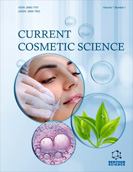Abstract
Background: Due to growing environmental concerns, eco-friendly and sustainable materials have become one of the key interests of cosmetics research. Isopropyl myristate is being used as a major cosmetic ingredient, like in many other cosmetic items, as an emollient for a long time.
Methods: An emollient ester, isopropyl ricinoleate, is derived from non-edible oil, castor oil. The synthesized isopropyl ricinoleate using greener enzyme catalysed methodology was further tested for sensory evaluation and transepidermal water loss (TEWL) studies.
Results: An ester, isopropyl ricinoleate, imparted better gloss and shine to the skin as compared to isopropyl myristate due to its higher refractive index. Both esters, isopropyl ricinoleate and isopropyl myristate, showed minimum tackiness and residue after spreading. Moreover, insilico toxicity analysis of ester, isopropyl ricinoleate, supported previously reported in-vitro toxicity data.
Conclusion: Thus, the current study provides better insights on the replacement of emollient ester isopropyl myristate by isopropyl ricinoleate.
Keywords: Emollient ester, isopropyl ricinoleate, enzyme targets, sensory evaluation, transepidermal water loss (TEWL), green synthesis.
Graphical Abstract
[http://dx.doi.org/10.1016/B978-0-12-821218-9.00010-4]
[http://dx.doi.org/10.1111/j.1396-0296.2004.04S1006.x] [PMID: 14728699]
[http://dx.doi.org/10.1016/j.xphs.2017.03.016] [PMID: 28341597]
[http://dx.doi.org/10.1016/B978-0-12-818228-4.00011-3]
[http://dx.doi.org/10.1080/10915810701663150] [PMID: 18080873]
[http://dx.doi.org/10.5650/jos.62.153] [PMID: 23470442]
[http://dx.doi.org/10.1016/j.procbio.2015.07.014]
[http://dx.doi.org/10.1016/j.btre.2015.10.006] [PMID: 28352582]
[http://dx.doi.org/10.1002/slct.201901775]
[http://dx.doi.org/10.1007/BF02637678]
[http://dx.doi.org/10.1007/s11746-999-0245-6]
[http://dx.doi.org/10.1038/srep42717] [PMID: 28256516]
[http://dx.doi.org/10.1093/nar/gku293] [PMID: 24792161]
[http://dx.doi.org/10.2174/1386207323999200325125858] [PMID: 32209038]
[http://dx.doi.org/10.2174/1573409916666200302120942]
[http://dx.doi.org/10.1016/j.colsurfb.2020.111122] [PMID: 32498002]
[http://dx.doi.org/10.1016/j.colsurfa.2017.07.025]
[http://dx.doi.org/10.1039/C7NJ00884H]
[http://dx.doi.org/10.1016/j.molstruc.2021.130337]
[http://dx.doi.org/10.1002/cmdc.201600182] [PMID: 27218427]
[PMID: 9599698]
[http://dx.doi.org/10.1002/qsar.200430906]

















